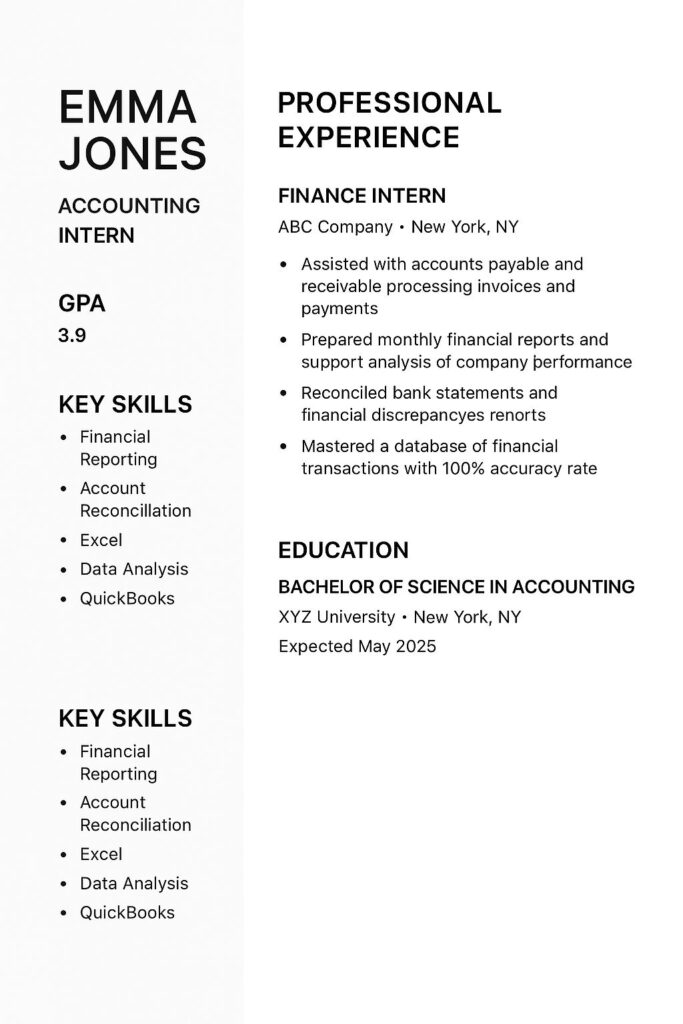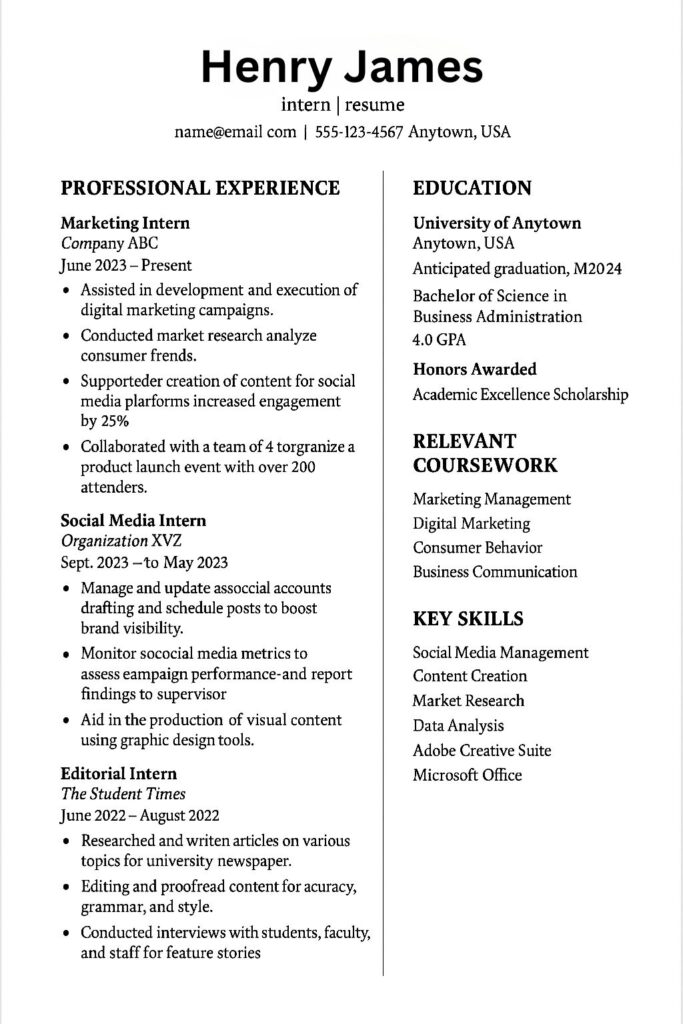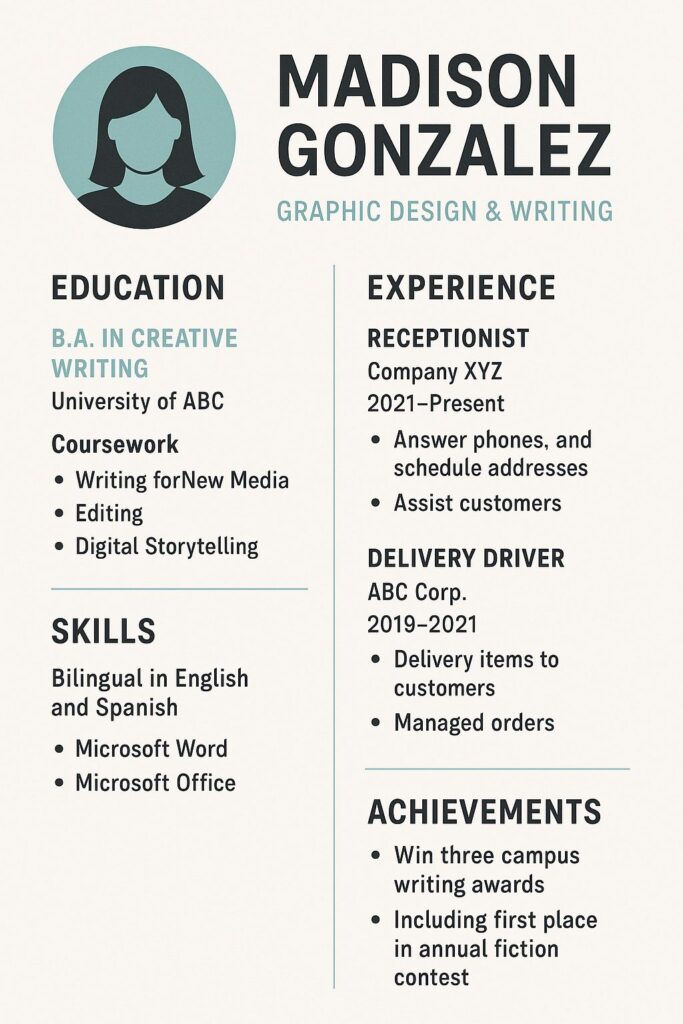
Resume Objective for Freshers: Crafting Your Career Objective
June 14, 2025
Top 10 Common Resume Mistakes for Freshers and How to Avoid Them
July 4, 2025Internship Resume for Freshers: How to Write a Resume for Internship That Stands Out
Landing your first internship can feel like a big step, but a well-crafted resume can help you stand out. After all, your resume is often your first contact with an employer. Career experts note that an internship resume is your “first point of contact” and should be “well-crafted and tailored to the internship being applied for, highlighting relevant skills and experiences”. In other words, a strong resume brands your unique value and helps you shine “amongst a sea of applicants”.
Resume writing is a crucial skill for freshers, as it enables you to present your strengths effectively and increases your chances of securing valuable internship opportunities.
For many freshers (new graduates or college students), that means highlighting your education, projects, and enthusiasm, since work experience may be limited. This guide will show you how to write a resume for an internship step by step, with practical tips and examples to build your confidence and get results.
Why a Great Internship Resume Matters
First impressions count. An internship resume shows employers your potential, even if you’re a fresher. Think of it as your personal marketing brochure. As one career blog expert puts it, the resume “acts as a branding tool, showcasing an individual’s unique value proposition and increasing their chances of standing out”. In simple terms, a strong internship resume helps you get noticed and get the interview. It highlights achievements (even school ones) and communicates your skills clearly. For example, if you include a high GPA, relevant projects, or leadership roles, these details can impress busy hiring managers.
An engaging resume that uses measurable accomplishments and strong action verbs can help you stand out to potential employers. As Indeed’s internship guide explains, an internship resume often focuses on your academic program and skills from school projects or volunteer work. By crafting your resume carefully, you can show how your classroom learning and extracurriculars prepare you for real-world work. In short, a polished internship resume is your ticket to interviews, so it’s worth investing time to get it right.
Choosing the Right Resume Template
First, pick a clean, professional template. For interns, simplicity is key. Fancy fonts or colours can distract, so use a straightforward design. It is advisable to use “a clear and straightforward resume template” that lets recruiters quickly find your best qualifications. When creating a professional resume for an internship, it’s important to select the right resume format, such as chronological, functional, or combination, to best showcase your skills and experience. Using an internship resume template designed for students or recent graduates can help ensure your resume is ATS-friendly, visually organised, and tailored for internship applications. That means using a classic layout (often reverse-chronological or combination) with easy-to-read fonts like Arial, Calibri or Times New Roman in 10–12 pt size.
Avoid cluttered or highly decorative templates. The goal is readability. In practice, choose a design with clear section headings (like Education, Experience, Skills) and consistent formatting (same bullet style, line spacing, margins). Use bold or ALL CAPS for section titles so they stand out. Keep it uniform: one font for all text, one style for headings, etc..
This resume example uses a clean sidebar layout. The student’s name and target role (“Accounting Intern”) are prominent, and a sidebar highlights key info (GPA, skills). The content is organised into clear sections (Professional Experience, Education, Key Skills).
This resume example uses a clean sidebar layout. The student’s name and target role (“Accounting Intern”) are prominent, and a sidebar highlights key info (GPA, skills). The content is organised into clear sections (Professional Experience, Education, Key Skills).
In this template, notice how the left side quickly shows the student’s name, career objective, and educational highlights (like “3.9 GPA” and relevant coursework). The right side lists experience with bullet points. This kind of clear, two-column format makes it easy for recruiters to scan your strengths. When choosing a template, ask yourself: “Can I see my most important info at a glance?” If yes, you’re on the right track.

Crafting a Strong Objective or Summary
When crafting your resume as a fresher, begin with either a targeted resume objective or a resume summary at the top. A resume objective is a concise statement outlining your career goals, enthusiasm for the specific internship, and what you aim to contribute—ideal for high school students, college students, or recent graduates entering the workforce. In contrast, a resume summary provides a brief overview of your professional experience, valuable skills, and achievements, making it suitable for those with more experience or completed internships. The main difference is that an objective focuses on your aspirations and fit for the role, while a summary highlights your qualifications and most relevant skills to quickly attract the hiring manager’s attention.
For example, a recent graduate or college student can use a resume summary to showcase their most relevant skills and valuable skills gained through coursework, projects, or extracurricular activities. This approach helps demonstrate readiness for professional roles and makes your application stand out. Here’s an example of a resume objective for a high school student seeking a dream internship:
“Motivated high school student eager to secure a dream internship in environmental science, highlighting strong problem-solving and teamwork skills developed through science club projects.”
This not only states your goal but also highlights specific skills that align with the internship.
Here are two sample objectives from internship resumes (from entry-level students):
“Hard-working and passionate student (3.8 GPA) capable of meeting strict deadlines. Seeking to apply strategic analytical skills to the Reporter/Researcher Internship at The Middlebrook Times. Possess proven writing and research abilities.”
“Energetic and passionate graduate student working toward an MS in Marketing at the University of Georgia. Aiming to use consumer research skills and knowledge of advertising, PR, and product development to fill the open Marketing Internship role at Athens Advertising.”
Both examples name the role and company, and hint at relevant strengths. Notice they include GPA, major, and key skills like research or communication. You don’t have to copy these word-for-word, but they show the idea: be specific, enthusiastic, and tie your background to the internship.
Tip: If you’ve already completed internships or substantial projects, you could write a short professional summary instead, focusing on achievements and highlighting specific skills that match the internship. For most freshers, an objective is ideal. Make it brief (1–3 sentences) and customise it for each internship application, tailoring your objective or summary to the hiring manager’s expectations. Always highlight skills that are most relevant to the internship, as this will help your resume stand out and show you understand what the employer is looking for. A personalised objective or summary grabs attention and shows you understand the employer’s needs right from the top.
Detailing Your Education, Relevant Coursework, and Experience
As a student, your education section is a star. If you have limited work history, put education near the top, just below your objective. List your degree, school name, and graduation date (or expected date). If your GPA is strong (generally 3.6 or above), include it here, as it can impress recruiters. Your educational background is a key section, as it provides employers with insight into your academic background and the foundation of your academic knowledge.
Under education, add any academic achievements and accomplishments that align with the internship. For example, one resume shows a “Dean’s List for 6 semesters” entry, which signals high achievement. If you have awards (scholarships, academic competitions) or relevant certificates, list them too. A career guide suggests adding honours shows that “you’ve been recognised for your hard work and accomplishments.” Highlighting your academic background and academic accomplishments demonstrates your commitment and potential to excel in the internship position.
Another key is relevant courses. List 3–5 classes that relate directly to the role. For instance, a communications major applying for a media internship might list courses like “Writing for Mass Media” or “Journalism Workshop.” The resume example below demonstrates this:
EDUCATION
Bachelor of Arts in Communications, University of Washington, Seattle WA (2023–2026)
Relevant Coursework: Foundations of Journalism, Advanced Journalism, Writing for Mass Media. Dean’s List (6 semesters).
Including specific course names gives employers a concrete sense of your academic knowledge and background. Just remember to list only relevant coursework. Listing every class dilutes the impact. Focus on classes that taught skills or knowledge useful to the internship.
If you have work experience (even part-time jobs, previous internships, or volunteering), describe it in a short “Experience” section. Use bullet points to explain what you did and what you accomplished. Even if it’s not in the same field, emphasise relevant experience, transferable skills (customer service, teamwork, organising, etc.), and teamwork skills. For example, a part-time tutor position might showcase your communication and responsibility. Every bullet should start with an action verb (more on that next) and, when possible, include numbers or results. Be sure to list your experiences in reverse chronological order, starting with your most recent internship experience or previous internship experience. For example, if you worked as a legal intern, describe your practical experience by highlighting tasks such as drafting legal documents, conducting research, and collaborating with attorneys.
If your school has categories like Projects, Research, or Extracurricular Activities, consider adding those as separate sections. It will be a wise idea to include a “Major Achievements” or “Projects” section for students. For example, include academic projects that demonstrate hands-on skills and practical experience, as well as volunteer experience to showcase your commitment and real-world involvement. For example:
Major Achievements:- Reporter, Heritage High Newspaper (Sept 2021–Present) – Covered the boys’ varsity basketball team through a state championship run, resulting in a 20% increase in game attendance.
Lead Organiser, Campus Film Festival (Mar 2023) – Coordinated 5 campus-wide film screenings, managing a team of volunteers.
In that example, note the bold heading (“Reporter”) and the bullet point that explains a real result (20% increase in attendance). The key is quantifiable impact. Whenever possible, attach a number or specific outcome to your tasks (ticket sales, participation numbers, time saved, etc.). This turns vague duties into clear achievements.
Finally, if you hold any relevant positions like club officer, volunteer coordinator, or team captain, list them. These illustrate leadership, transferable skills, and initiative. For instance, the same example above might list “Captain, Volleyball Team (2024)” to highlight responsibility and team skills.
In this sample intern resume, the student’s education and achievements are highlighted in a sidebar. Notice the 4.0 GPA, “Relevant Coursework,” and “Key Skills” sections on the right. The professional experience is listed in bullet points on the left. This organised layout helps the reader quickly see credentials.

Using Strong Action Verbs and Quantifying Impact
The words you choose in your bullet points make a big difference. Always start bullets with strong action verbs, not bland phrases. For example, say “Developed a marketing plan” instead of “Was responsible for developing a marketing plan.” Move away from passive wording like “responsible for” or “in charge of.” Instead, punch it up: “Coordinated social media content to reach 2,000 followers,” or “Analysed sales data to improve project outcomes.”
Why? Because, as one career resource explains, active verbs “help quantify your achievements, demonstrate your capabilities, and distinguish you from other candidates”. Using powerful verbs paints a picture of someone taking initiative. Here are some excellent action verbs for intern resumes: Achieved, Adapted, Analysed, Collaborated, Created, Developed, Evaluated, Executed, Improved, Implemented, Managed, Planned, Researched, Streamlined, Supported.
For internship roles in particular, pick verbs that show learning and growth. It is suggested that interns use words like “developed,” “gained,” or “implemented,” since they imply you’ve quickly applied new knowledge. If you see something relevant in the job description (e.g., “mentored,” “launched,” “designed”), try to match it with what you’ve done.
Whenever you describe a task, quantify the results if you can. Numbers grab attention and prove your impact. Instead of “Participated in campus events,” try “Organised 3 club events that attracted over 100 students each.” Rather than “Helped update website,” say “Updated website content, increasing visitor engagement by 15%.” Even small percentages or time frames help (e.g., “3-month project”, “5 new clients reached”).
For example, one student’s resume reads: “Covered the boys’ varsity basketball team during its championship run, resulting in a major boost to school spirit and helping drive a 20% increase in ticket sales”. This bullet uses a percentage (20%) and a clear action (covering games) to make the accomplishment measurable. Aim for that clarity in your own resume.
Showcasing Your Skills
After experience and education, include a Skills section to spotlight your abilities at a glance. This section is your chance to list any key talents not detailed elsewhere. Include both hard and soft skills relevant to the internship. Indeed advises that this section “includes any abilities not represented in other sections… tailor this section to the skills identified within the job posting”.
Hard Skills: These are specific tools, technologies, or techniques. For example, list programming languages (e.g., Python, Java), software (e.g., Excel, SPSS, Adobe Photoshop), or lab methods (e.g., PCR, data analysis) if they relate to the internship. If you’re applying to a finance internship, you might include “Financial Modelling, Excel, QuickBooks.” For marketing, “SEO, Google Analytics, Canva.” For design, “Adobe Illustrator, UI/UX Design.” Be honest: only include skills you know.
Soft Skills: These are personal attributes. Common ones are communication, teamwork, problem-solving, leadership, time management, etc. For instance, if you’ve led a student project or worked in a team, you likely have teamwork and communication skills. If you’ve balanced coursework and a part-time job, highlight time management. These traits matter in any field.
Languages: Being bilingual is a big plus in many internships. If you speak another language, list it (e.g., “Spanish (fluent), French (conversational)”). The editorial and hospitality resume examples both pointed out bilingual abilities as strengths.
Organise your skills section clearly, usually with bullets or columns. Some people title it “Skills,” “Relevant Skills,” or “Key Skills.” Place it after your experience, or in a sidebar if your format allows. Use the job posting as a guide: if the posting emphasises “teamwork” or a specific software, make sure those words appear in your skills list. Aligning your skills with the employer’s needs can help you pass automated resume scanners.
Formatting Tips for a Clean, ATS-Friendly Resume
Keep your resume layout uniform and professional. Use consistent fonts (same typeface and size throughout) and spacing. Avoid using headers, footers, or text boxes that might confuse Applicant Tracking Systems (ATS). Use bullet points to break up text and make information digestible.
Some concrete tips:
Length: One page is ideal for internship resumes. Most experts agree that a single page ensures clarity and brevity. Keeping your resume concise is crucial—focus on relevant, impactful content to maximise effectiveness. If you fill it with your most important details, you likely won’t need a second page. Only extend to a second page if you have significant achievements (e.g., major research projects, leadership roles) that truly add value. Otherwise, one page is enough.
Font and Size: Stick with standard fonts like Arial, Times New Roman, or Calibri. Use 10–12 point font for body text. Don’t use tiny fonts to squeeze in more words. A slightly smaller font in headings (14–16 pt) is fine for your name or section titles.
Headings: Make your section headings bold or underlined and a bit larger. This helps the reader navigate. For example, write EDUCATION, EXPERIENCE, SKILLS in all caps or bold.
Alignment: Use left-aligned text. Right-aligned dates or locations are okay if consistent. Avoid centred text for body paragraphs – left-aligning is easier to read.
White Space: Don’t cram everything. Margins of about 0.5–1 inch give room. Use line spacing (~1.15–1.2) to avoid clutter. A resume with some breathing room is more inviting.
Sections Order: Usually put Objective/Summary at the top, then Education (for freshers), then Experience, Projects/Achievements, then Skills, and maybe extra sections (Activities, Certifications). If you have a strong technical skill set, some guides recommend a Combination/Hybrid resume format – one that leads with skills summary before experience. This can be useful if you want to showcase specific proficiencies early.
File Format: Submit as PDF unless instructed otherwise, to preserve formatting. Name your file simply (e.g., Janet_Resume.pdf) so it looks professional.
Before sending, proofread carefully! Even a small typo can make a bad impression. Use spellcheck and have a friend review it. A resume with errors will likely get tossed. Read each line to ensure consistency (e.g., are all dates in the same format? Are bullet points aligned?).
The Power of the Cover Letter
While the resume lists your credentials, the internship cover letter is where you tell your story. An internship cover letter complements your resume by providing context: it shows why you’re interested and how you fit the role. Think of the internship cover letter as a conversation. It’s where you can highlight your passion and personality, and expand on points in your resume.
For internship cover letters, focus on relevant projects, coursework, and personal motivation. You should “consider highlighting skills gained through coursework, projects, or extracurricular activities” and emphasise soft skills with specific examples. For instance, if you built a class project or participated in a hackathon, briefly describe it and connect it to the internship’s work. If you volunteered or joined a club, explain how those experiences taught you valuable lessons (leadership, teamwork, etc.).
Your cover letter should also explain why this internship and company excite you. Did you read a recent company news or admire its mission? Mention it. This shows you’ve done your homework and truly want that internship, not just “any ol’ job”. Keep it professional but friendly – use “I” statements to make it personal.
Format-wise, keep the cover letter to one page (3–4 paragraphs). Begin with a greeting (try to use the hiring manager’s name if you know it). In the first paragraph, say what position you’re applying for and where you found it. In the middle paragraphs, highlight 1–2 key skills or experiences from your resume and explain them more fully (for example, “In my Service Marketing course project, I led a team to create a campaign that increased club membership by 30%”). In the final paragraph, reiterate your enthusiasm and thank the reader for considering you.
Remember: the internship cover letter is not just a formality. It’s a chance to sell yourself beyond bullet points. Use it to complement your resume, filling in any gaps (e.g., a job change or a brief pause in school). When combined with a strong resume, a tailored internship cover letter can significantly boost your application’s impact.
Tailoring Your Resume by Industry
When crafting your resume, start by reviewing internship resume examples available all over the internet to guide your approach. These samples can help you understand how to structure your information and highlight your strengths for internship applications. For students, especially those early in their careers, a college student resume format is often most effective, focusing on academic achievements, relevant coursework, and extracurricular activities.
Different fields look for different cues. Here are some quick tips on how to tweak your internship resume depending on the industry:
Tech (Software/Engineering): Emphasize coding projects, hackathons, and technical coursework. List programming languages and tools (Python, Java, SQL, Git, etc.). In your experience bullets, mention specifics: e.g., “Developed a mobile app feature using React Native, improving user login speed by 15%”. As one tech intern example notes, highlighting “technical skills in application development and database management, along with experience using React” makes a resume strong. If you have Github or a portfolio, include the link. Mention any internships or lab work too. For those applying to a summer internship program, consider using a summer internship resume format, which includes an objective statement tailored to the specific program and highlights relevant skills and experiences.
Marketing/Media: Showcase creativity and communication. Relevant coursework might include Advertising, Digital Marketing, or Journalism. Mention projects like blog writing, video creation, or social media campaigns. Highlight data analytics tools (Google Analytics, SEO) if learned. An editorial intern resume example highlights an English degree and creative writing skills, plus bilingual ability, to add value in publishing. If you run a personal blog or have social media stats, consider noting them (e.g., “Grew Instagram page to 1,000+ followers through content strategy”). Use action verbs like “Launched,” “Promoted,” “Designed,” and quantify outcomes (clicks, followers, sales).
Finance/Accounting: Put GPA and relevant coursework (Accounting, Economics, Finance) front and center. Include any finance certifications (like Bloomberg Market Concepts). In experience, note attention to detail: e.g., “Reconciled accounts for a student organization, ensuring 100% accuracy in financial reports.” The internship example above mentions a 4.0 GPA and courses in auditing and cost accounting as strengths. Also list tools like Excel, QuickBooks, or SQL. Soft skills such as “analytical,” “detail-oriented,” and “organized” fit well here.
Design/UX: Your resume itself should be visually clean, but consider adding a link to your portfolio. Mention design software (Adobe Suite, Figma, Sketch). If you have design projects (posters, websites), describe them: e.g., “Created a branding poster using Adobe Illustrator, which was displayed at a campus event.”
Research/Science: Highlight any lab or research experience. List relevant techniques (e.g., PCR, spectroscopy) or software (MATLAB, R, SPSS). Quantify research achievements: “Analysed 200+ survey responses, improving data accuracy by 25%.” The research intern guide suggests emphasising “data collection, statistical analysis, and proficiency in software tools like SPSS or R,” and always “quantifying contributions” like efficiency gains. Mention if you co-authored any papers or led a project in class. Soft skills like “critical thinking” and “attention to detail” are also key here.
Other Fields: For HR internships, highlight communication and coordination skills, and tailor your resume for internship candidates applying to an internship program by emphasising relevant education, certifications, and objectives. For hospitality/tourism, show customer service and language skills (as one hospitality resume did with a 3.9 GPA and leadership roles). Always tailor your keywords: if the internship calls for “teamwork, Microsoft Excel, or customer relations,” make sure those words appear in your resume.
The graphic design intern example below even uses design terms and metrics:
This creative resume sample highlights a candidate’s graphic design and writing skills. The left column lists her BA in Creative Writing, coursework, and key software (Word, Office). The right column shows experience (Receptionist, Delivery Driver) and achievements (campus writing awards). Notably, it mentions her bilingual skills and relevant writing achievements.
In design or creative fields, quality matters. Use nice typography and clear hierarchy, but don’t overdo graphics. If it fits the role, you might lay out your resume more creatively (columns, colour accents). But ensure any colours or shapes don’t break ATS reading or distract from the content.

The general principle: Match your resume to the role. If the posting lists certain skills, and you have them, explicitly include them. If it values leadership or creativity, reflect that in your bullets. You’re telling the reader: “Look, this is exactly who you’re looking for.” For more inspiration, review additional internship resume examples to see how others have successfully structured their applications.
Top Tips & Common Mistakes to Avoid
Here are some final pointers and pitfalls to be aware of:
Use specific language: Avoid vague phrases like “worked on SkyDive LLP.” Instead, use detail: “Recruited, trained and supervised 20+ volunteers at the community centre, improving event attendance”. Employers love specifics. One job advice site contrasts “worked with employees in a restaurant” (boring) with “recruited, hired, trained and supervised more than 20 employees in a restaurant with $2 million in annual sales”. The latter clearly shows scope and results.
Tailor each resume: Never send a generic resume to every application. Most career expert warns that a “one–size–fits–all” resume usually ends up in the trash, because it signals you’re not invested in that company. Instead, tweak keywords and emphasis for each internship. If a posting highlights “research skills,” make sure your resume mentions a project where you researched data. This also helps with ATS scanning, which looks for those keywords. For recent graduates, focus on academic achievements, relevant coursework, and extracurricular activities to demonstrate your skills. Experienced candidates should strategically organise their resumes to highlight relevant projects and specialised skills that match the role, especially in fields like sustainability or green technology.
Highlight accomplishments, not just duties: It’s easy to fall into listing what you did day-to-day. A mistake is writing only duties (e.g., “Attended group meetings and recorded minutes”). Instead, convert each bullet to show impact. For example, “Recorded weekly meeting minutes and compiled them into a searchable database for future reference”. You want to answer, “How did you make a difference?” or “What was the outcome?”.
Proofread and polish: Typos or formatting errors can kill your chances. One resume tips article bluntly advises: if your resume isn’t grammatically perfect, employers will assume “this person doesn’t care”. Read your resume slowly, use spellcheck, and get someone else to proofread it. A clean, error-free resume shows professionalism.
Avoid cliches and fluff: Skip overused phrases like “hard-working individual seeking career growth.” These add no information. Instead, be concrete. Also, avoid filler sections like “Interests” unless they’re relevant (e.g., “Photography” for a design role). Space is limited, so use it wisely.
Use action verbs: We can’t stress this enough. Opening bullets with verbs (Created, Organised, Improved, etc.) pack a punch. Career guides remind us that “action verbs” are must-haves on a resume. They make you sound proactive rather than passive.
Focus on format and length: As mentioned, one page is usually enough. Don’t cram tiny text, and don’t exceed 2 pages. Each section (education, experience, etc.) should be clearly labelled. Keep all dates aligned and consistently formatted.
Show growth and attitude: Especially as a fresher, employers look for your potential. Phrases in your resume or cover letter like “eager to learn” or “seeking to develop new skills” demonstrate the right mindset. In your resume, this can be implicit through your achievements and clubs or your objective statement.
Take Action and Stay Confident
Writing your first internship resume might feel daunting, but remember: everyone starts somewhere. Use this guide to craft a resume that truly reflects your strengths. As one expert notes, a well-structured, goal-driven internship resume “creates a positive first impression”. Show your unique mix of skills, education, and enthusiasm. Double-check your formatting, proofread carefully, and tailor each version to the role.
Most importantly, believe in yourself. Highlight what you have done – even as a student, you have achievements worth sharing. Use action verbs, concrete examples, and a bit of creativity. By taking these steps, you’ll build confidence in your application. Now is the time to put pencil to paper (or fingers to keyboard). Start drafting your internship resume, and don’t be afraid to ask mentors or friends for feedback. Every update will make it stronger.
Your next internship opportunity is within reach. With a standout resume and a tailored cover letter, you’ll be ready to show employers just how capable you are. Go ahead – take action today. You’ve got this!
Good luck with your internship search!




